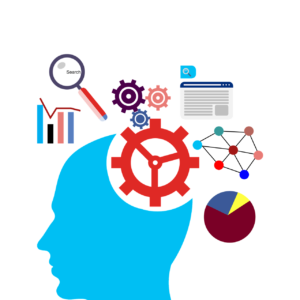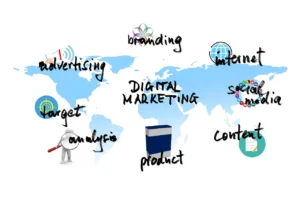AI digital advertising has evolved dramatically, driven by technological advancements and the growing integration of artificial intelligence (AI) digital advertising strategies. AI has reshaped paid advertising by enabling targeted, personalized, and highly effective campaigns that resonate with audiences.
This article delves into the transformative role of AI-driven advertising platfofms, exploring key technologies such as DMPs, DSPs, SSPs, and leading platforms like Google Ads, Facebook Ads, and TikTok Ads. We’ll also discuss predictive actions and attribution modeling, highlighting how AI enhances campaign performance and ROI.

Transforming the Digital Advertising Landscape
In today’s fast-paced digital world, businesses are constantly seeking ways to enhance their advertising strategies and connect with their target audiences in more effective ways. One of the most significant advancements in the field of digital advertising is the rise of AI-driven advertising platforms. AI’s ability to process vast amounts of data and generate actionable insights has revolutionized how businesses approach advertising. Through AI, companies can now create more precise campaigns, maximize engagement, and drive conversions like never before.
This article explores the key technologies behind AI-driven advertising platforms, such as DMPs (Data Management Platforms), DSPs (Demand-Side Platforms), and SSPs (Supply-Side Platforms). We’ll also take a closer look at how AI is being used in leading advertising platforms like Google Ads, Facebook Ads, and TikTok Ads, and how these platforms are shaping the future of digital marketing.
Understanding the AI Advertising Ecosystem: DMPs, DSPs, and SSPs
To understand how AI-driven advertising platforms work, it is essential to familiarize yourself with the key technologies that power them. These include Data Management Platforms (DMPs), Demand-Side Platforms (DSPs), and Supply-Side Platforms (SSPs). Together, these platforms form a seamless ecosystem that drives precision and efficiency in digital advertising.
1. Data Management Platforms (DMPs)
DMPs play a crucial role in the AI-driven advertising ecosystem. These platforms collect, manage, and segment customer data from various sources, creating a centralized repository for insights. By gathering data on customer behaviors, preferences, demographics, and interactions, DMPs enable businesses to:
- Segment audiences based on specific characteristics, such as browsing history, purchase patterns, or interests.
- Refine targeting strategies to ensure that ads reach the most relevant audience.
- Enhance ad personalization, which leads to better engagement and higher conversion rates.
By leveraging the power of AI, DMPs help businesses make data-driven decisions and improve the effectiveness of their campaigns.
2. Demand-Side Platforms (DSPs)
Demand-Side Platforms (DSPs) enable businesses to purchase advertising space programmatically. With the integration of AI, DSPs allow businesses to target the most relevant audiences at scale. AI-driven algorithms analyze vast amounts of data from DMPs to optimize the bidding process and refine targeting strategies. This leads to:
- More effective ad placement, ensuring ads reach users who are most likely to convert.
- Real-time optimization of campaigns, adjusting bidding strategies and targeting based on customer behaviors.
- Increased ROI, as AI ensures businesses get the most out of their advertising budgets by placing ads in front of the right audience at the right time.
By leveraging AI in DSPs, businesses can scale their advertising efforts while maintaining high levels of targeting precision.
3. Supply-Side Platforms (SSPs)
Supply-Side Platforms (SSPs) are used by publishers to manage and sell their ad inventory programmatically. SSPs enable publishers to optimize ad placements and maximize revenue by connecting them with multiple DSPs. When AI is integrated into SSPs, it helps:
- Enhance the efficiency of ad auctions, allowing publishers to sell their ad inventory to the highest bidder.
- Optimize ad placements in real time by analyzing various factors, such as user behavior, device type, and geographical location.
- Improve monetization by ensuring ads are displayed to the most relevant users, leading to higher engagement rates.
In combination with DMPs and DSPs, SSPs create a robust AI-driven advertising ecosystem that benefits both advertisers and publishers.
How AI is Revolutionizing Leading Advertising Platforms
Leading advertising platforms like Google Ads, Facebook Ads, and TikTok Ads have harnessed the power of AI to transform digital advertising. By integrating AI into their platforms, these companies are enabling businesses to create highly targeted campaigns that deliver exceptional results. Let’s explore how each platform is using AI to improve the advertising experience.
1. Google Ads
Google Ads is one of the most widely used AI-driven advertising platforms, offering businesses the ability to target users across Google’s vast network. AI plays a central role in optimizing ad campaigns, and here’s how it works:
- Analyzing Search Patterns: Google Ads leverages AI to analyze search trends and patterns, enabling advertisers to target users based on their search intent. By understanding what users are searching for, AI helps businesses place their ads in front of the most relevant audience.
- Keyword Optimization: AI algorithms identify the most effective keywords for targeting, ensuring that ads are shown to users who are actively searching for related products or services.
- Optimizing Bidding Strategies: AI optimizes bidding strategies in real-time, adjusting bids based on factors such as user behavior, device type, and location. This helps businesses get the most out of their ad spend.
With AI, Google Ads ensures that businesses can maximize their ad budget and reach the right audience at the right time, increasing the chances of conversion.
2. Facebook Ads
Facebook Ads is another powerful AI-driven advertising platform that offers businesses the ability to target users based on their interests, demographics, and behaviors. AI enhances the targeting capabilities of Facebook Ads in the following ways:
- User Behavior Analysis: AI analyzes user behavior on the platform, such as likes, comments, and shares, to understand user preferences and interests. This allows businesses to segment audiences and deliver highly personalized ads.
- Audience Segmentation: AI segments audiences based on their actions and interactions, allowing advertisers to target users with content that is most relevant to them. This leads to better engagement and higher conversion rates.
- Campaign Optimization: Facebook Ads uses AI to optimize ad delivery, adjusting bids and targeting based on real-time performance data. This helps businesses improve ROI and ensure that their ads are seen by the most relevant users.
By leveraging AI, Facebook Ads enables businesses to create highly targeted ad campaigns that resonate with their audience and drive better results.
3. TikTok Ads

TikTok has rapidly emerged as a popular platform for digital advertising, especially among younger audiences. AI-driven advertising platforms like TikTok Ads provide businesses with the tools to engage users in unique and creative ways. Here’s how TikTok uses AI to optimize advertising:
- Audience Identification: TikTok’s AI algorithms analyze user behavior and content interactions to identify the most relevant audience segments. By understanding what users engage with, AI ensures that ads are shown to users who are likely to find them interesting.
- Ad Spend Optimization: AI helps optimize ad spend by determining the most effective times to show ads and adjusting bids based on audience behavior. This leads to better ROI for advertisers.
- Leveraging Trending Content: TikTok’s AI identifies trending content and incorporates it into advertising strategies, enabling businesses to tap into viral trends and boost their campaign visibility.
TikTok’s AI-driven approach provides businesses with a unique opportunity to engage with highly active, younger audiences and deliver personalized ad experiences that drive results.
The Future of AI-Driven Advertising Platforms
The future of AI-driven advertising platforms looks incredibly promising, with continuous advancements in AI technologies enabling businesses to create more sophisticated and effective ad campaigns. Some of the key trends we can expect to see in the future include:
- Greater Personalization: As AI continues to evolve, businesses will be able to deliver even more personalized ad experiences, ensuring that every interaction resonates with the target audience.
- Voice and Visual Search Integration: With the rise of voice assistants and visual search technologies, AI-driven platforms will integrate voice and image recognition to enhance ad targeting and engagement.
- Enhanced Automation: AI will continue to automate many aspects of the ad creation, targeting, and optimization process, reducing the time and effort required to run successful campaigns.
Businesses that embrace AI-driven advertising platforms will be well-positioned to stay ahead of the competition and achieve greater success in their digital marketing efforts.
The impact of AI-driven advertising platforms has transformed the digital advertising landscape, enabling businesses to create highly targeted, personalized campaigns that drive better engagement and higher conversion rates. By leveraging platforms like Google Ads, Facebook Ads, and TikTok Ads, businesses can optimize their ad spend, enhance customer experiences, and maximize their ROI.
As AI continues to evolve, the future of digital advertising looks even brighter. Businesses that embrace these technologies will be able to stay ahead of the competition and reach their target audiences in more meaningful ways

Applications of AI-Driven Advertising Platforms: How AI Transforms Digital Marketing
In the world of digital marketing, AI-driven advertising platforms are changing the game. By harnessing the power of artificial intelligence, businesses can now enhance targeting, personalize ad content, optimize ad spend, and ultimately drive better results. These platforms provide unprecedented insights into customer behavior and allow companies to tailor their advertising strategies in real-time, ensuring maximum impact and higher returns on investment (ROI).
This article explores the key applications of AI-driven advertising platforms, including predictive actions, attribution modeling, and the numerous benefits they offer to digital marketers. It also delves into the challenges businesses face when implementing AI-driven advertising strategies and how to overcome them.
Key Applications of AI in Digital Advertising
Predictive Actions: Forecasting Customer Behavior
One of the most powerful features of AI-driven advertising platforms is predictive analytics. These platforms use machine learning algorithms to analyze vast amounts of data and predict future customer actions. By understanding customer behavior and trends, businesses can make data-driven decisions that optimize ad campaigns for better results. Here are the key benefits of predictive actions:
- Enhanced Targeting: Predictive AI allows businesses to show ads to users who are most likely to engage with the ad or convert into customers. For example, AI can predict which users are likely to complete a purchase after viewing an ad, helping businesses focus their efforts on high-potential leads.
- Optimized Ad Spend: AI-powered platforms allocate resources to high-potential audience segments, ensuring that ad budgets are used efficiently. This reduces waste and helps businesses maximize the impact of every dollar spent on advertising.
- Increased Conversions: Predictive insights enable businesses to craft follow-up campaigns tailored to user behavior. By targeting individuals who are most likely to engage, predictive actions help increase conversion rates and improve the overall effectiveness of ad campaigns.
For example, if AI predicts that a user is likely to purchase after seeing a specific ad, businesses can target that user with a follow-up email or display ad, offering an additional incentive to complete the transaction.
Attribution Modeling: Understanding the Value of Marketing Channels
Attribution modeling is another area where AI-driven advertising platforms excel. This process involves evaluating the various marketing channels that contribute to a customer’s conversion. AI-powered attribution modeling helps businesses:
- Analyze Customer Journeys: AI tracks how users interact with different touchpoints, including social media ads, search engine results, email campaigns, and more. By understanding the entire customer journey, businesses can better understand how users move through the purchasing funnel.
- Identify High-Impact Channels: AI identifies which marketing channels are most effective in driving conversions. For instance, businesses can determine whether Facebook ads or Google search ads are the primary drivers of sales.
- Optimize Campaigns: With AI-powered attribution, businesses can allocate advertising budgets to the channels that provide the best return on investment. By optimizing ad spend across high-performing platforms, companies can ensure that their campaigns achieve the highest possible success.
Through AI-driven advertising platforms, businesses gain deeper insights into the performance of their marketing efforts. This leads to more informed decision-making and better campaign optimization.
The Benefits of AI-Driven Advertising Platforms
Improved Targeting
One of the key advantages of AI-driven advertising platforms is their ability to enhance targeting. Traditional advertising often struggles to reach the right audience at the right time. However, AI can analyze vast amounts of data—such as browsing behavior, purchase history, and demographic information—to ensure ads are shown to the most relevant users. This leads to more efficient ad campaigns with higher engagement and conversion rates.
For example, AI-driven platforms can deliver personalized ads to users based on their interests, search history, and past interactions with a brand. By narrowing down the target audience, businesses can ensure their advertising efforts are highly focused and effective.
Enhanced Personalization
Personalized ad content is crucial for driving engagement in today’s competitive digital landscape. AI-driven advertising platforms excel at creating tailored experiences for users. By analyzing individual preferences, behaviors, and purchase history, AI enables businesses to create highly personalized ad content that resonates with their audience. This level of personalization increases engagement and encourages users to take the desired action, whether it’s clicking on an ad or making a purchase.
For instance, AI can automatically adjust the text, images, and offers in an ad based on the specific user viewing it, creating a more engaging and relevant experience.
Greater Efficiency
AI streamlines many aspects of digital advertising, from content creation to bidding strategies. By automating routine tasks, AI-driven advertising platforms allow businesses to save time and reduce manual effort. This increased efficiency leads to faster campaign execution and a reduction in the resources required to manage ads.
AI-powered tools also automate bidding strategies, ensuring businesses get the best possible ad placements without the need for constant manual adjustments. This automation not only saves time but also ensures that campaigns are optimized for maximum impact.
Higher ROI
One of the most compelling reasons businesses are adopting AI-driven advertising platforms is the ability to achieve higher returns on ad spend. By improving targeting, optimizing ad placement, and personalizing content, AI helps businesses maximize the effectiveness of their advertising campaigns. As a result, businesses can expect a higher ROI on their marketing investments.
AI-driven platforms help reduce wasted ad spend by ensuring that ads are shown to the most relevant audience, at the most effective times, and through the most suitable channels.
Real-Time Adaptation
AI’s ability to adapt to changing conditions in real time is another key benefit of AI-driven advertising platforms. As campaigns run, AI continuously monitors performance and makes adjustments to improve outcomes. This includes adjusting targeting, changing bidding strategies, or modifying ad creatives based on real-time data.
For example, if an ad is performing poorly in one region, AI can quickly adjust the campaign to focus on high-performing areas or alter the messaging to improve engagement.
Challenges in Implementing AI Digital Advertising
While the benefits of AI-driven advertising platforms are clear, businesses may encounter some challenges when implementing these tools:
Data Privacy Concerns
With AI’s reliance on vast amounts of customer data, businesses must ensure compliance with privacy regulations such as GDPR. Customers are increasingly concerned about how their data is used, and businesses must take steps to protect their privacy and maintain transparency. AI-driven advertising platforms must prioritize ethical data practices to build trust with consumers and comply with legal requirements.
Initial Investment
Adopting AI technologies requires a significant upfront investment. Businesses must invest in AI tools, platforms, and the necessary training for their teams. However, the long-term benefits, such as increased efficiency and higher ROI, often outweigh these initial costs. Companies must carefully assess the ROI potential of AI-driven advertising before making the investment.
Complexity
Managing AI-driven advertising platforms can be complex, especially for businesses without a dedicated team of AI experts. To fully leverage AI, businesses may need to invest in training or hire specialists to ensure campaigns are executed effectively. However, with the right tools and expertise, AI can become a powerful ally in driving digital advertising success.
AI-driven advertising platforms are revolutionizing the way businesses approach digital marketing. From enhanced targeting and personalization to real-time adaptation and higher ROI, these platforms provide businesses with the tools they need to optimize their advertising efforts. By embracing AI, businesses can improve their advertising campaigns, engage customers more effectively, and ultimately drive better results.
Despite the challenges associated with implementing AI in digital advertising, the benefits far outweigh the hurdles. By addressing issues such as data privacy and complexity, businesses can unlock the full potential of AI-driven advertising and stay ahead of the competition in the digital marketplace.
FAQs AI Digital Advertising
- What is AI in digital advertising?
AI in digital advertising involves using artificial intelligence to enhance targeting, personalization, and optimization in paid ad campaigns. - How does AI improve paid advertising?
AI analyzes customer data, predicts behavior, and automates processes, enabling more effective targeting and higher ROI. - What are DMPs, DSPs, and SSPs?
- DMPs: Platforms for managing customer data.
- DSPs: Tools for purchasing ad space programmatically.
- SSPs: Systems for publishers to manage and sell ad inventory.
- How does AI impact Google Ads and Facebook Ads?
Google Ads uses AI for keyword targeting and bidding optimization, while Facebook Ads employs AI for audience segmentation and personalization. - What is predictive advertising?
Predictive advertising uses AI to forecast customer behavior, allowing businesses to create highly targeted and effective campaigns. - What are the benefits of attribution modeling with AI?
AI-powered attribution modeling identifies the most impactful marketing channels, optimizing campaign strategies and budgets.
Conclusion: AI-Driven Advertising Platforms
AI has revolutionized digital advertising, offering businesses unprecedented opportunities to create targeted, personalized, and effective campaigns. From platforms like Google Ads and Facebook Ads to predictive actions and attribution modeling, AI ensures that every aspect of paid advertising is optimized for success.
For businesses looking to stay competitive in the digital landscape, integrating AI into their advertising strategy is no longer optional—it’s essential.
Author

Welcome to my blog. I’m passionate about helping people unlock the potential of the internet to achieve financial freedom.Exploring ways to earn money online while balancing my personal and professional life. Over time, I’ve learned the ins and outs of everything from [freelancing, affiliate marketing, dropshipping, blogging etc].I aim to share actionable tips, proven strategies, and honest reviews to guide you in starting or growing your online income. Whether you’re looking to earn a side income or build a full-fledged online business, I’m here to help!


